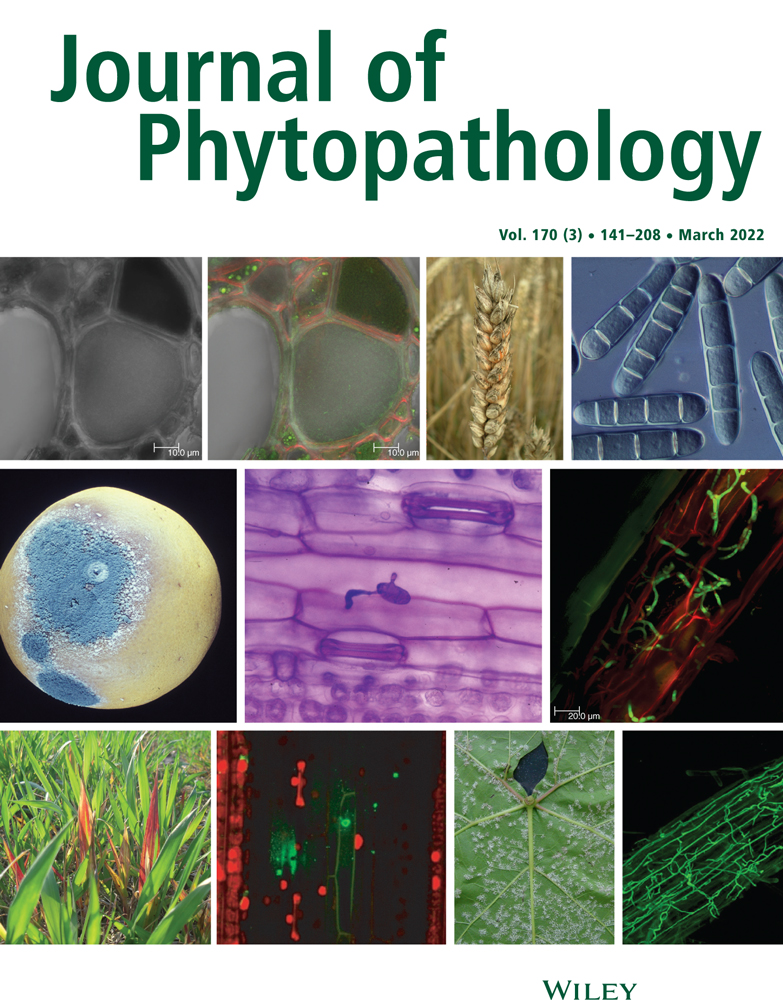Ver ítem
- xmlui.general.dspace_homeCentros e Institutos de InvestigaciónCIAP. Centro de Investigaciones AgropecuariasInstituto de Patología VegetalArtículos científicosxmlui.ArtifactBrowser.ItemViewer.trail
- Inicio
- Centros e Institutos de Investigación
- CIAP. Centro de Investigaciones Agropecuarias
- Instituto de Patología Vegetal
- Artículos científicos
- Ver ítem
Morphological and molecular characterization, pathogenicity and sexual reproduction of Ascochyta rabiei isolates of chickpea fields in Argentina
Resumen
Ascochyta blight is one of the most devastating foliar diseases of chickpea. The causal agent, Ascochyta rabiei, is a heterothallic ascomycete and its sexual reproduction depends on the proximate presence of both mating types, MAT1-1 and MAT1-2. Since its first detection in Argentina in 2011, very few studies have been carried out and information on local isolates remains unknown. In this work, 12 isolates were obtained from the northern, central and
[ver mas...]
Ascochyta blight is one of the most devastating foliar diseases of chickpea. The causal agent, Ascochyta rabiei, is a heterothallic ascomycete and its sexual reproduction depends on the proximate presence of both mating types, MAT1-1 and MAT1-2. Since its first detection in Argentina in 2011, very few studies have been carried out and information on local isolates remains unknown. In this work, 12 isolates were obtained from the northern, central and southern regions of Córdoba province, Argentina. First, isolates were tentatively identified as A. rabiei based on their colony and conidial characteristics. Identity was confirmed by phylogenetic analysis of the ITS, β-tubulin and D1/D2 loci. Morphology, cultural characteristics and pathogenic variability of the isolates were compared. Likewise, 27 crosses were made to demonstrate possible sexual reproduction between the strains. The isolates showed differences in morphology (shape, texture, conidial size, colony colour, growth rate) and aggressiveness from a susceptible cultivar. All crosses were fertile and produced pseudothecia, asci and ascospores. This work is the first in Latin America to characterize isolates of A. rabiei morphologically and molecularly, examine their pathogenic variability and demonstrate the sexual reproduction between isolates carrying different mating-type idiomorphs. New levels of aggressiveness in A. rabiei or adaptive changes like resistance to fungicides or breakdown of host resistance are a distinct possibility in the future.
[Cerrar]

Fuente
Journal of Phytopathology 170 (1) : 1-12. (January 2022)
Fecha
2022-01
Editorial
Wiley
ISSN
1439-0434 (online)
Documentos Relacionados
Formato
pdf
Tipo de documento
artículo
Proyectos
(ver más)
INTA/2019-PE-E6-I132-001/2019-PE-E6-I132-001/AR./Desarrollo de legumbres adaptadas a los territorios y diferenciados por calidad comercial, nutricional e industrial.
INTA/2019-PD-E4-I090-001/2019-PD-E4-I090-001/AR./Análisis de patosistemas en cultivos agrícolas y especies forestales. Caracterización de sus componentes
Palabras Claves
Derechos de acceso
Restringido
 Excepto donde se diga explicitamente, este item se publica bajo la siguiente descripción: Creative Commons Attribution-NonCommercial-ShareAlike 2.5 Unported (CC BY-NC-SA 2.5)
Excepto donde se diga explicitamente, este item se publica bajo la siguiente descripción: Creative Commons Attribution-NonCommercial-ShareAlike 2.5 Unported (CC BY-NC-SA 2.5)

